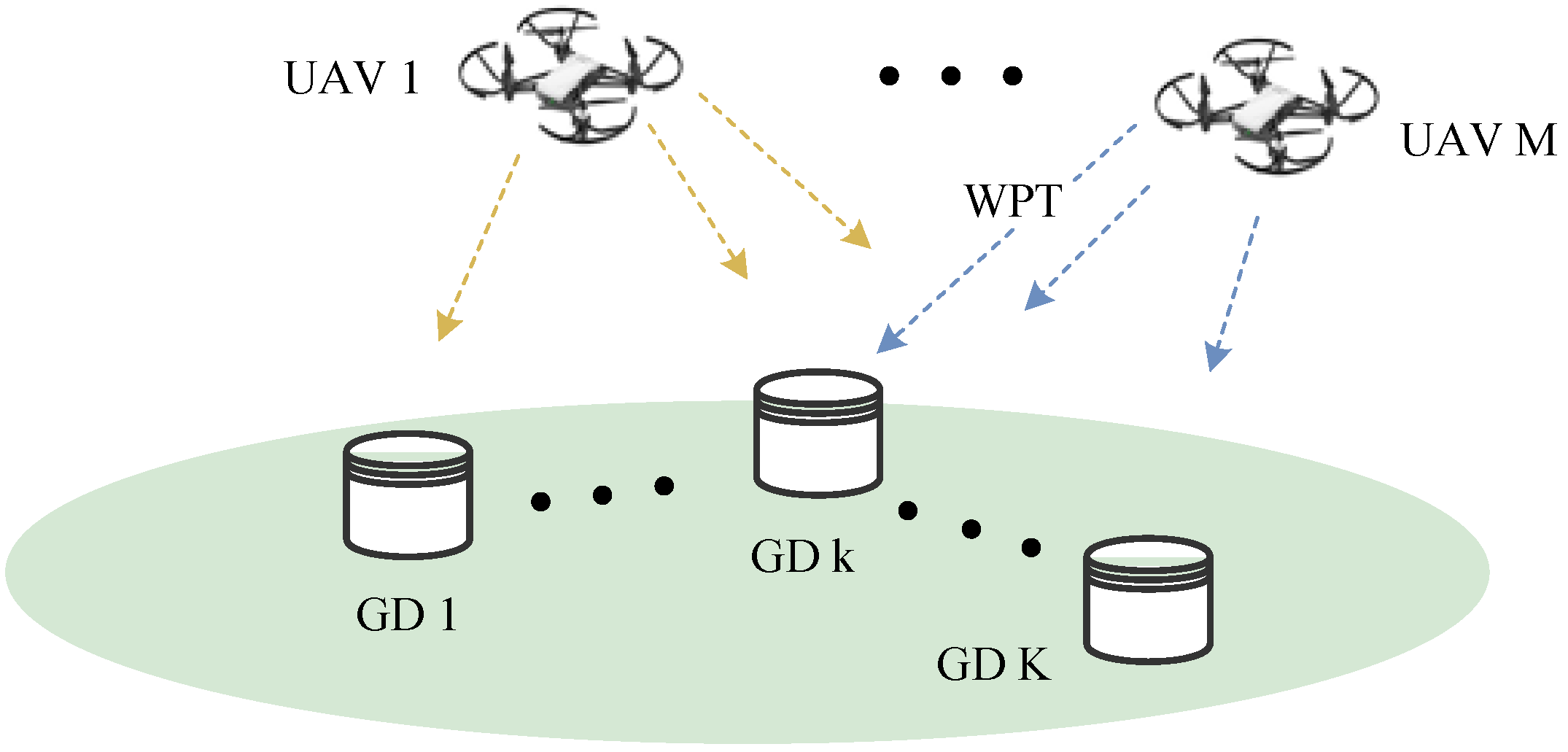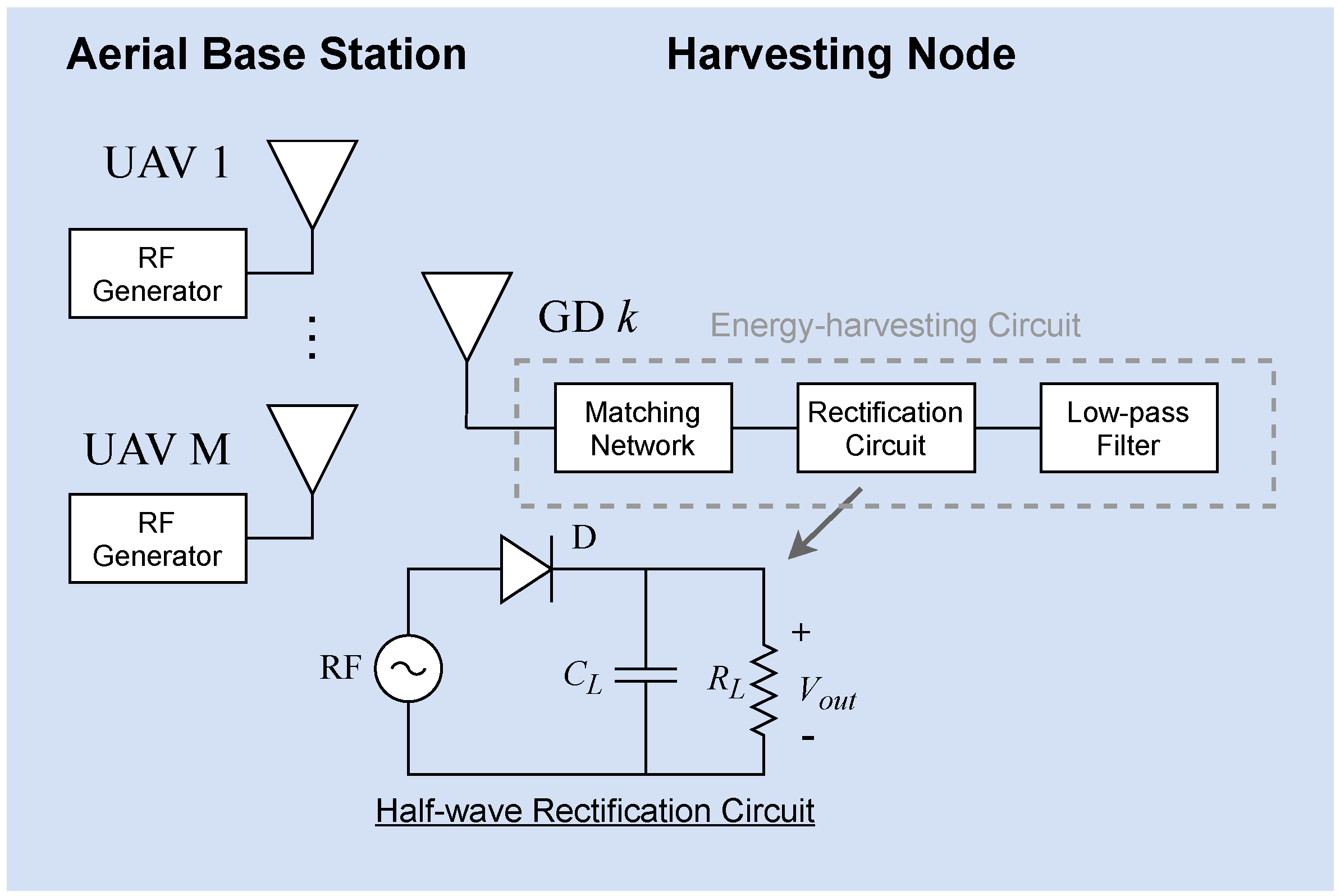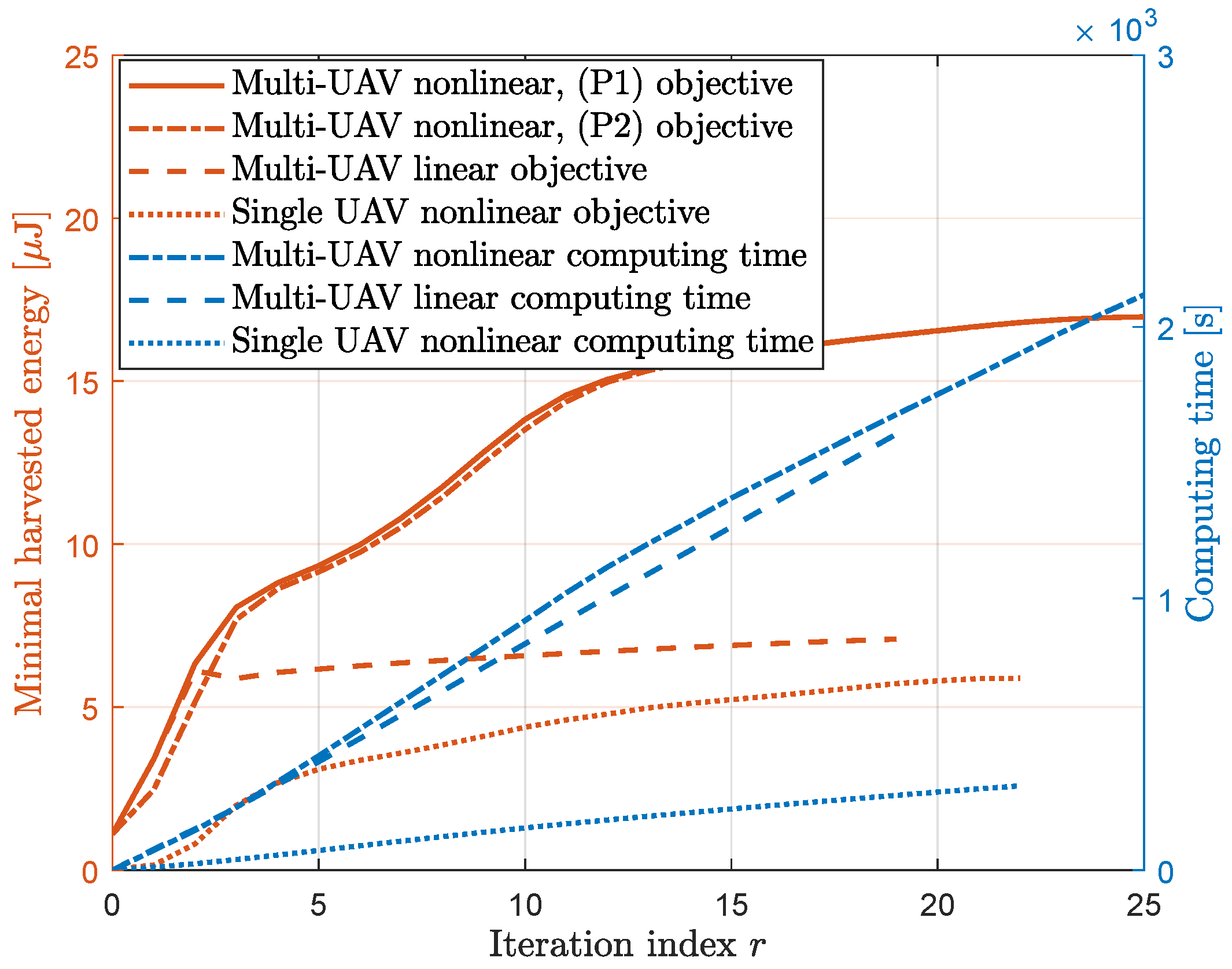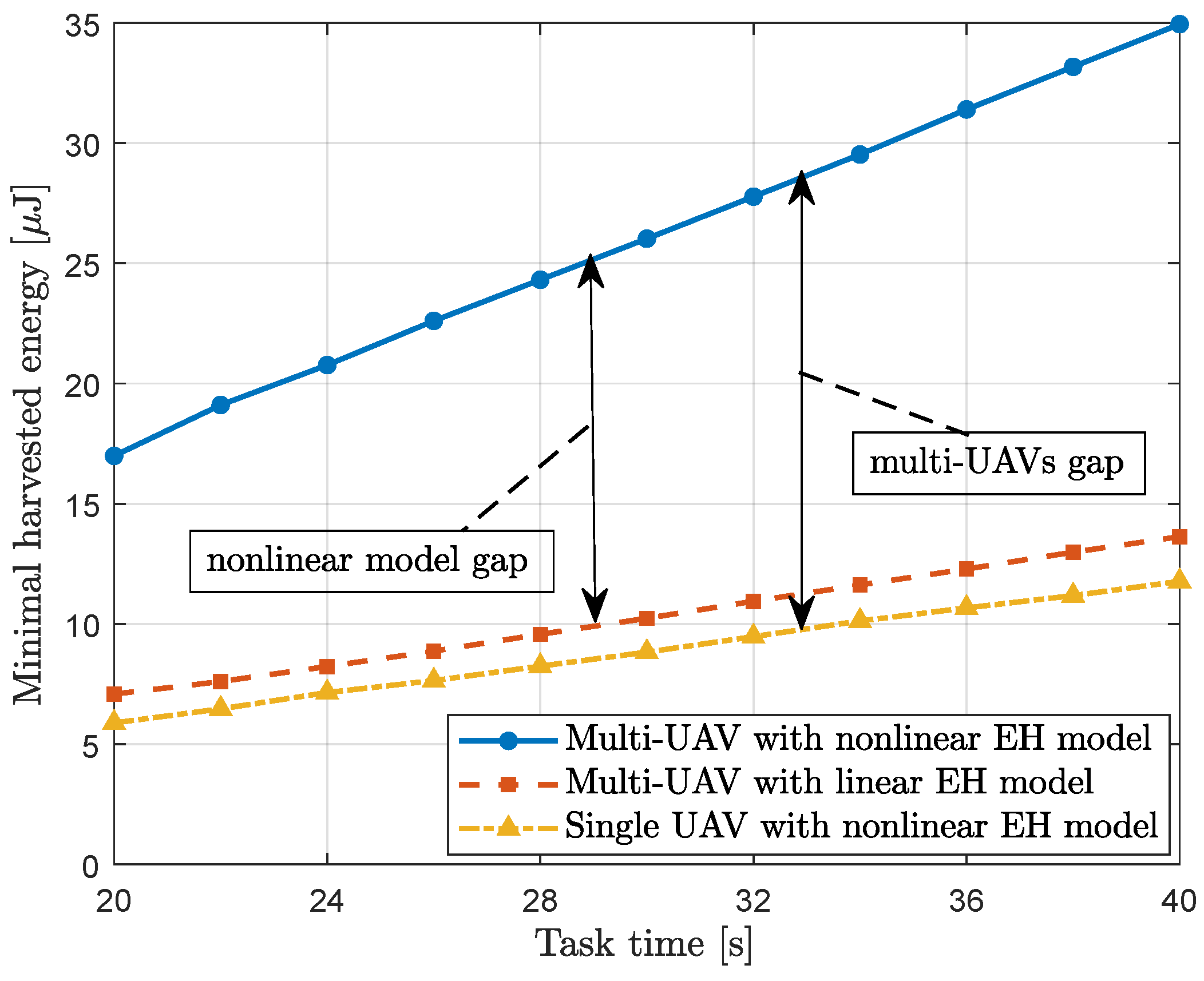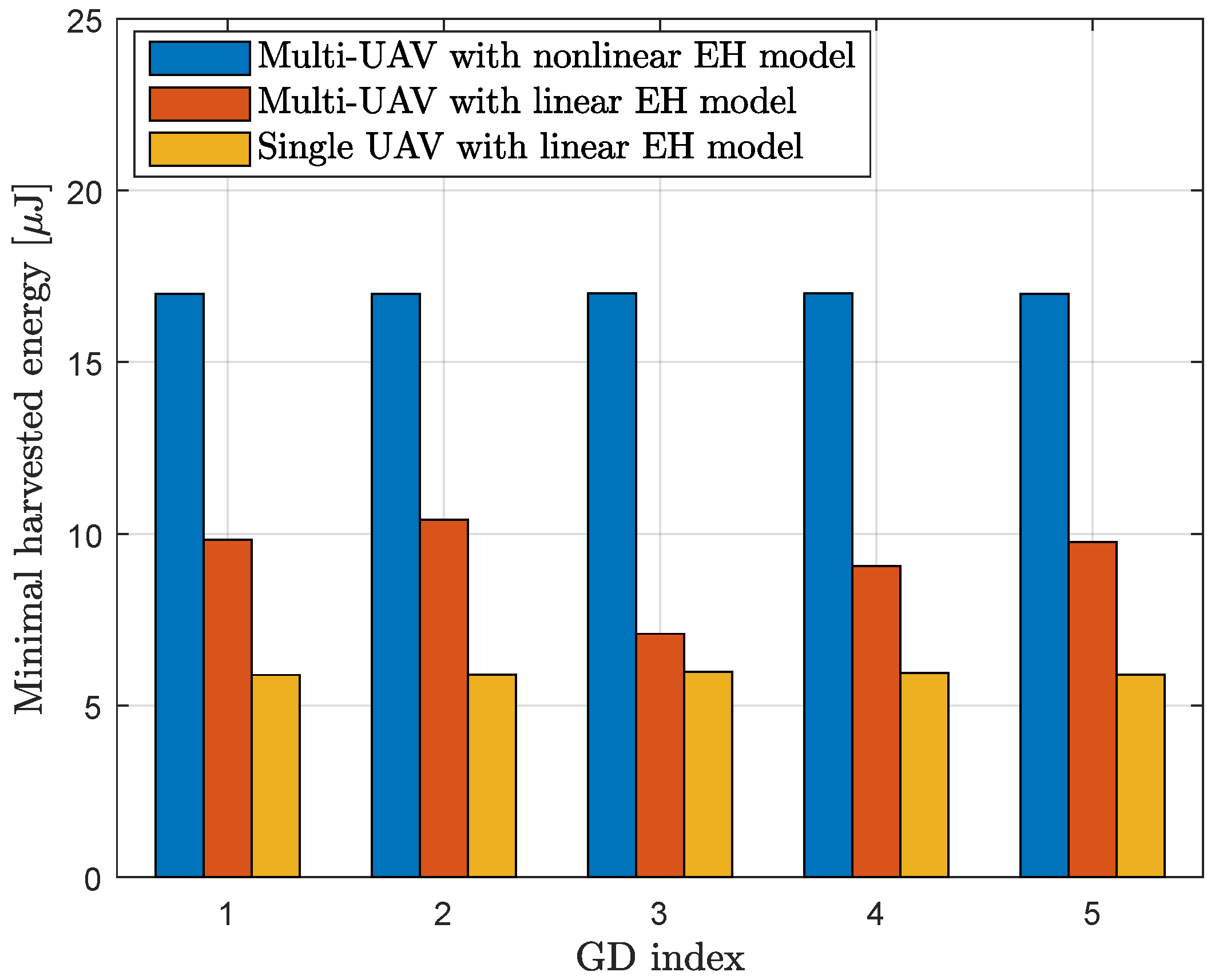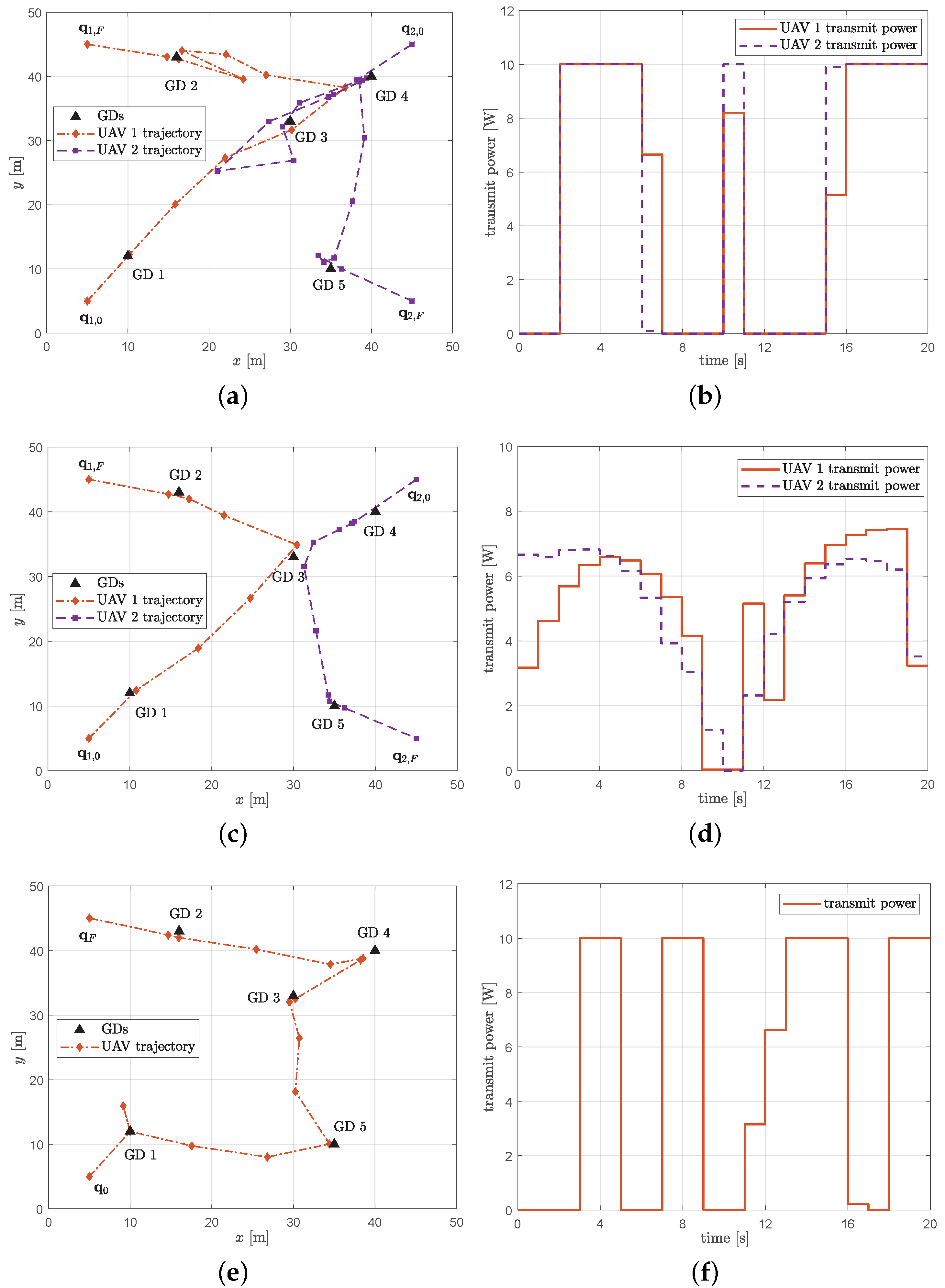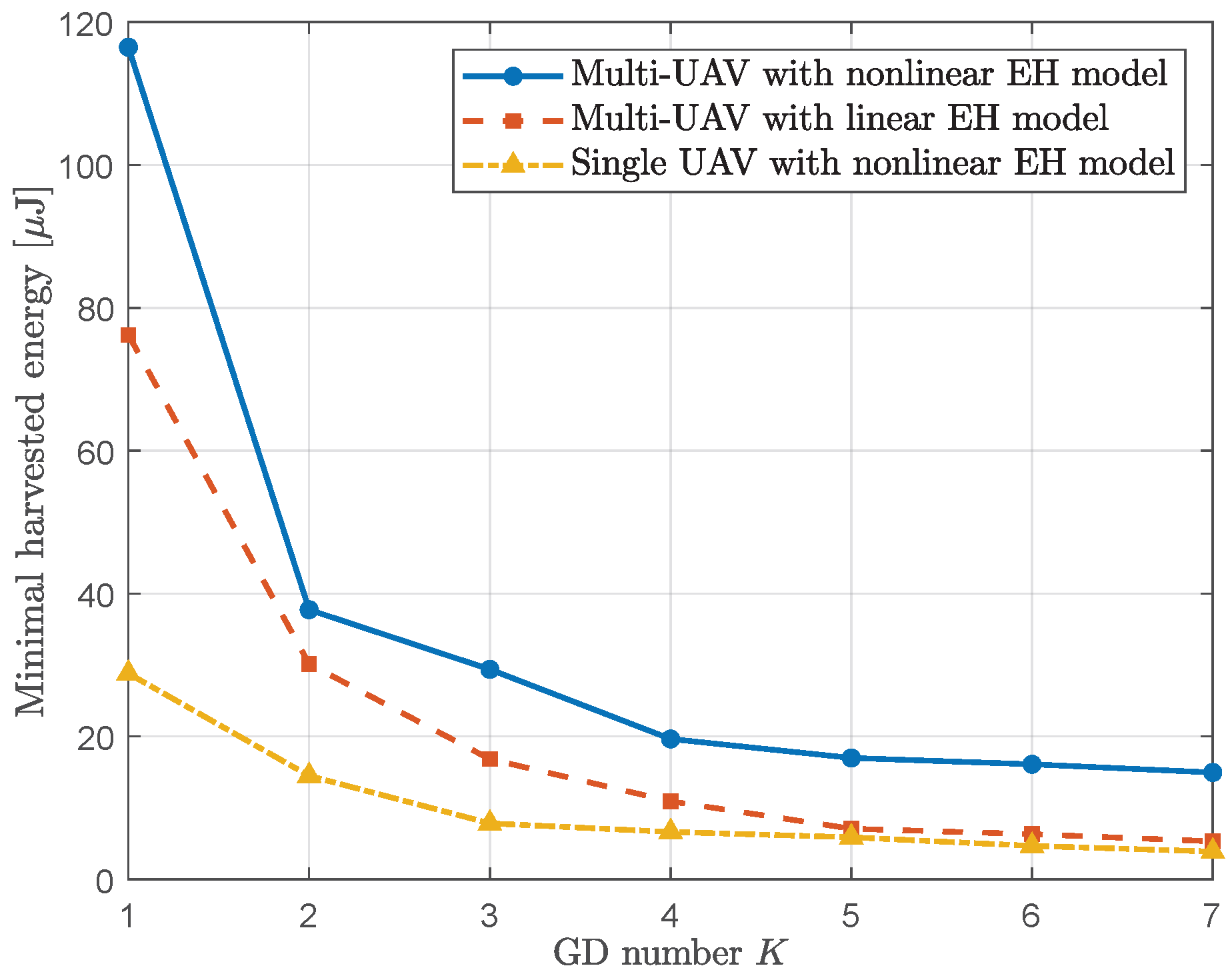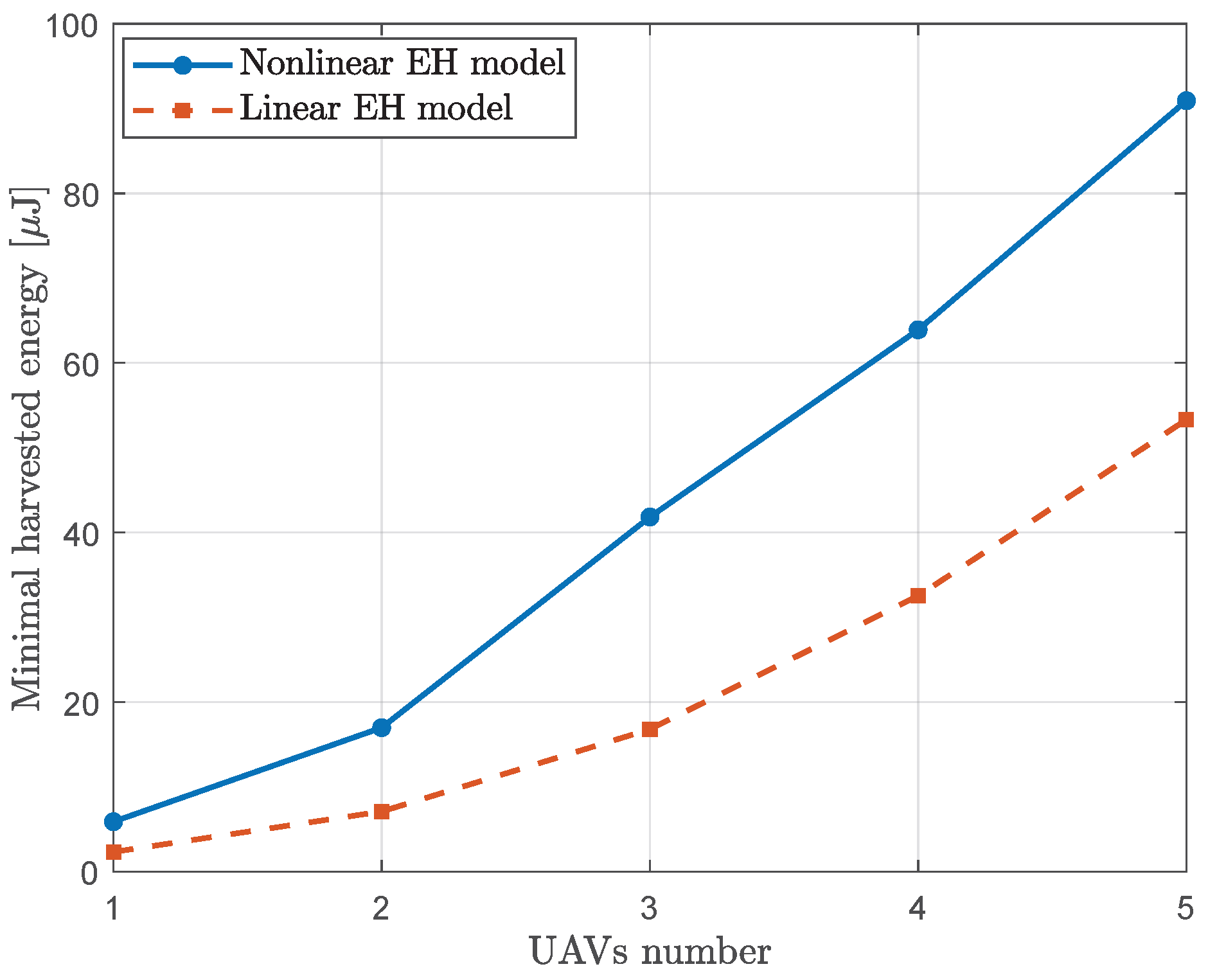1. Introduction
Unmanned aerial vehicles (UAVs) attract much attention and show widespread adoption in the civilian domain thanks to their remarkable characteristics, including high flexibility, streamlined construction, maneuverability, and cost-effectiveness. UAVs have a large number of civilian applications, such as cargo transportation [
1], disaster management [
2], and data collection [
3]. Due to the advantages mentioned above, UAVs have been extensively explored together with wireless networks and have demonstrated innovative solutions to improve the channel capacity [
4,
5,
6], coverage [
7,
8], communication security [
9,
10,
11], etc. In particular, the exceptional mobility exhibited by UAVs has led to considerable scholarly interest in UAV-assisted networks, attracting a number of efforts, as it offers promising avenues for improved network performance. For example, considering a UAV serving as a moving base station, authors in [
12,
13] significantly improved the throughput for ground users by designing a UAV trajectory and determining the transmit power. In addition, employing a UAV as the relaying node, in [
14,
15], the authors maximized the minimum information rate through the UAV trajectory design. Moreover, UAV trajectory design has also been applied to areas such as UAV data collection systems [
16,
17] and UAV-assisted data offloading [
18] to enhance the system performance. Considering more general channel models, the authors in [
19,
20] adopted a Rician fading model to characterize the channel when a UAV flies with a sufficiently high altitude, and formulated a 3D trajectory and user scheduling design for system performance enhancement in a UAV-enabled wireless communication network. In contrast, with a low flying height, in [
20], the authors adopt the probabilistic line-of-sight (PLoS) model, where the flying path is designed to improve the energy utilization efficiency.
On the other hand, resulting from the rapid development of wireless sensor networks (WSNs) and the Internet of Things (IoT), the integration of wireless power transfer (WPT) technology into UAV-assisted wireless networks has been shown to be a promising method in prolonging the operational lifespan of energy-constrained nodes. To improve the energy transfer efficiency, the trajectory design of the UAV-assisted WPT network was explored in previous works [
21,
22,
23,
24,
25]. Additionally, extensive research has been conducted on the co-design of the trajectory and resource allocation, for further improved energy transfer efficiency. In particular, some previous works focused on the co-design of a trajectory and transmission strategy [
26,
27]. In addition, a UAV trajectory was designed together with user scheduling [
28], directional antenna orientation [
25], and computing resources [
29]. Moreover, the design of UAV trajectories has been extended to other applications, such as mobile edge computing (MEC) systems [
30,
31], wireless powered communication networks (WPCN) [
32], and simultaneous wireless information and power transfer (SWIPT) [
33]. Specifically, an effective co-design strategy for UAV trajectory and resource allocation is extensively researched in [
33], in consideration of both the communication requirement and energy supply of ground nodes.
1.1. Related Work
In the workflow of the WPT technique, the energy harvesting (EH) circuit plays a critical role in converting the radio frequency (RF) signal into an available direct current (DC) signal that can charge the node battery. Notably, most previous works utilized the relatively simply linear EH model, where the harvested energy is linearly connected with the received RF power. The trajectory design of a single UAV-assisted WPT network based on a linear EH model has also been extensively studied. For instance, in light of the fairness issue, the authors in [
21] considered 1D UAV trajectory optimization with two energy receivers limited by the UAV’s maximum speed. Based on the results in [
21], 2D UAV trajectory design under the multi-user WPT system is further studied in [
22], where the optimal UAV trajectory structure is proposed to achieve a complexity reduction. On the basis of the previously proposed optimal UAV trajectory structure, a globally optimal design strategy for a UAV 1D trajectory is, for the first time, proposed for WPT efficiency enhancement. Due to the limitations of WPT technology and the huge path loss caused by long-distance propagation, GDs powered by a single UAV cannot operate for a long time in a large geographical area. To address the above issue, a few works have investigated multi-UAV trajectory design to increase the energy harvested by GDs [
34,
35,
36]. For instance, the authors in [
34], for the first time, presented a general utility maximization problem. Notably, the authors in [
34] extended their design strategy from a single-UAV to a multiple-UAV scenario and proposed two heuristic but efficient solutions. Given the limited energy capacity of UAVs, the authors of [
35] jointly optimized the selection of hovering positions and UAV trajectories to enhance the energy utilization efficiency of energy-constrained UAV wireless networks. Additionally, the authors of [
36] characterized the optimal trajectory as being evenly distributed over the circumference in the scenario of a dual-UAV-assisted WPT for a single energy receiver.
It is notable that the practical EH circuit typically implements the RF-to-DC conversion with semiconductor rectification elements such as diodes, which leads to a nonlinear relation between the received RF power and harvested energy. The nonlinear EH model that we adopt will be detailed in
Section 2.2. Considering a single UAV-assisted WPT network with the nonlinear EH model, the authors in [
24] considered 2D UAV trajectory design and proposed an efficient algorithm to determine the optimal UAV trajectory characteristics and obtained a high-quality solution. Adopting the same nonlinear EH model, the authors in [
25] designed a UAV trajectory with an orientation-designable directional antenna to enhance the amount of harvested energy. Adopting a different EH model, the authors in [
37] described the conversion process with a piecewise nonlinear EH model and jointly designed the UAV trajectory, task offloading, and computing resources. Although the above works with the nonlinear EH model have revealed some of the system’s intrinsic characteristics, which helps in enhancing the WPT performance, all of them focus on single UAV scenarios, and the trajectory design of multi-UAV-assisted WPT networks with the nonlinear EH model remains an unexplored solution to improve the energy transfer efficiency. As a result, joint trajectories and transmit power design in multi-UAV-assisted WPT networks with a multi-source nonlinear model remain an open issue in the literature, which motivated us to perform the present work.
1.2. Contributions
In this paper, we consider a multi-UAV-assisted multi-user WPT system. In particular, a practical multi-source nonlinear EH model is applied to calculate the total harvested energy by a single GD from multiple UAVs. To improve the WPT efficiency under the fairness-aware consideration, our objective is to maximize the minimal harvested energy among all GDs via jointly optimizing the UAV trajectories and transmit power, limited by constraints including anti-collision, maximum speeds, and transmit power budgets. The comparison of our work with related works is provided in
Table 1. Our main contributions are as follows.
Joint UAV trajectories and transmit power design with nonlinear EH model: Different from the previous works on multi-UAV trajectories and transmit power design with a simplified linear EH model, and those on single UAV trajectory and resource allocation design with the single-source nonlinear EH model, we apply the practical multi-source nonlinear EH model proposed in article [
39] for the first time to a more complicated scenario and characterize the harvested energy of each GD with respect to the UAV trajectory and transmit power. Accordingly, the co-design problem of UAV trajectories and transmit power is formulated, for minimal harvested energy enhancement limited by anti-collision, maximum speed, and transmit power constraints.
Efficient iterative algorithm executed via convex approximation: To address the complicated formulated problem with an implicit function for the multi-source nonlinear EH model, we provide an efficient iterative algorithm via convex approximation to address the formulated highly non-convex joint design problem. Specifically, utilizing the convexity where the harvested power holds for the reciprocal of the received power, which is proven through rigorous mathematical analysis, we construct the tightly lower-bound concave functions for the UAV distance and the harvested energy with respect to the UAV positions and transmit power in each iteration at the local point, allowing us to approximate the formulated problem as a convex one, which significantly reduces the difficulty in solving the problem and facilitates corresponding analysis. By solving these problems iteratively, the initial point converges to a satisfying solution. Additionally, the design complexity analysis of the proposed algorithm is provided.
Simulative validation and performance evaluation: Via simulation, we evaluate the performance of the proposed algorithm compared with benchmarks. It is shown that our proposed scheme outperforms the the cases with a single UAV and with the linear EH model under different scenarios, which confirms the advantages of the proposed scheme and the necessity of our work.
The remaining parts of this paper are structured as follows. In
Section 2, we introduce the considered multi-UAV-assisted multi-user WPT network and review the adopted multi-source nonlinear EH model, based on which we formulate the original joint UAV trajectories and transmit power design problem. In
Section 3, we provide a convex approximation method to transform the original non-convex problem into convex form and propose an efficient iterative algorithm, for which we analyze the complexity. Finally, numerical results are provided in
Section 4 and we conclude our work in
Section 5.
2. System Model and Problem Statement
In this paper, we consider a multi-UAV-assisted multi-user WPT network, depicted in
Figure 1, which consists of
M UAVs and
K randomly distributed GDs, whose locations are denoted by
in Cartesian coordinates, where the locations of all GDs are already known by the UAVs. To prolong the GDs’ working time, the UAVs play roles as energy resources to provide wireless harvested power to these GDs while flying from the initial point
to the final point
with height
H. In addition, assuming that all UAVs fly with a maximum flying speed
, the whole task time is
T, which generally depends on the UAV battery energy. Accordingly, the horizontal position and transmit power of UAV
at time
are represented by
and
, respectively.
As continuous time leads to an infinite variable
and
, to facilitate the network analysis, we adopt the time-discrete (TD) method, where the whole task time
T is equally discretized into
L slots denoted by
where the slot duration is
. The slot number
L is sufficiently large such that the trajectories and transmit power can be regarded as invariable variables in each slot, which are rewritten as
and
. Improtant notations are provided in
Table 2. We have the mobility constraint for UAV trajectories as
Note that
is limited by the UAVs’ hardware conditions, i.e., by the maximum allowed peak transmit power and average transmit power, represented by
and
, respectively. Thus, we have the transmit power budget constraint
In general, to avoid collision, it is required that there exists a safety distance
between UAVs to guarantee that the UAVs can keep the flight in a safe state, where the anti-collision constraint should be formulated as
2.1. Channel Model
In the considered scenario, we assume that the channels between UAVs and GDs are primarily LoS-dominant, where the assumption is practical in scenarios with few obstructions or a sufficiently high flying height, and, accordingly, at the
n-th moment, the channel power gain between UAV
m and GD
k is given by
where
represents the gain at a 1 m distance and
denotes the distance function between UAV
m and GD
k, which has convexity to
.
As a result, the received RF power of GD
k from UAV
m at the
l-th slot is formulated as
2.2. Nonlinear Energy Harvesting
As depicted in
Figure 2, after receiving the RF power, the GD subsequently converts it into available DC signals in the operating circuit through the internal nonlinear rectification circuit. The energy conversion circuit of the harvesting nodes consists of the receiving antenna, combined matching network, rectification circuit, and low-pass filter. In the energy-harvesting circuit, the role of the combined matching network is to filter the harmonics generated by the rectification elements and to match the impedance of the receiving antenna and rectification circuit correctly. Additionally, the low-pass filter is employed to suppress out-of-band fundamental and harmonics.
Different from most of the existing works on the multiple-UAV WPT network considering the simplified but inaccurate linear EH model [
35,
36], we consider the accurate multi-source nonlinear EH model adopted in our previous work [
39], which can accurately characterize the nonlinearity of the rectifier (diode) during DC conversion at the GD’s rectification circuit. In particular, the rectification circuit is a half-wave rectifier, as shown in
Figure 2, adopting a diode to achieve the nonlinear RF-to-DC conversion. According to the model, the output current of the rectification circuit for GD
k at the
l-th slot is given by
where
denotes the received RF power of GD
k at slot
l from all UAVs,
is the reverse bias saturation current,
refers to the principal branch of the Lambert W function and
, in which
,
and
denote the resistance of the energy storage unit, the ideality factor and the thermal voltage of the diode, respectively. Furthermore, the explicit expression for
according to [
39] is
where
is a positive constant and
is
where
denotes
and
is the constant waveform factor.
Therefore, the DC power harvested by GD
k from the superposition of multiple UAV signal sources is calculated by
Hence, the harvested energy of GD
k during the whole time period is
2.3. Problem Statement
In consideration of the fairness issue, to improve the wireless power transfer efficiency, our objective is to jointly design the trajectory and transmit power of each UAV to maximize the minimal harvested power among the GDs under some constraints, including mobility, transmit power and anti-collision constraints. Hence, the problem is formulated as
Note that both the harvested power function and the function in the anti-collision constraint are non-concave, which leads to the non-convexity of problem (P1) and makes it difficult to solve efficiently. To acquire an efficient solution for (P1), in the next section, we introduce a convex approximation method to construct a convex problem for (P1) at the local point, based on which an efficiently iterative algorithm is presented to solve (P1).
3. Proposed Joint Design Algorithm
To facilitate the corresponding mathematical analysis for problem (P1), in this section, we introduce a tight convex approximation for (P1) at the local point to iteratively solve the original problem. Specifically, we construct a set of lower-bound concave functions for the UAV distance function
at the left side of the anti-collision constraint (
5) and for the harvested power function
at the objective (
13), respectively, at the local point
. Then, an efficient iterative algorithm is proposed to solve (P1).
3.1. Anti-Collision Constraint Approximation
As
is a convex function, based on the convex property, we can approximate
as
where
is affine. Hence, the constraint (
5) can be reformulated in the following convex form:
3.2. Harvested Power Convex Approximation
According to the theorem proposed in [
39], the harvested power
is convex in
. In accordance with the theorem and the formulation (
12),
is convex to
. Based on the property of the convex function, we can similarly approximate
as
where the equality holds when
, i.e.,
and
.
and
are both positive constants and given as
where
is defined in partial derivative form due to the fact that the harvested DC power
is an implicit function but its specific value can be obtained through numerical calculation.
Moreover, in order to decouple the multiplicative terms of
and
, we apply the mean inequality, where, for
,
, and the equality holds when
. Based on the property, at the local point, we can further convert (
16) into
where the equality holds at the local point
and the positive constant
is given by
As
is jointly concave in
, above all, we have constructed the tightly lower-bound concave function for both the harvested energy function
and the distance function
at
. Substituting
and
by
and
, we can build the convex approximated problem for problem (P1) as follows:
As a convex problem, (P2) can be solved efficiently through the ellipsoid method. Consequently, we propose an iterative algorithm to solve the original problem (P1) via leveraging the convex approximation problem (P2). In the subsequent subsection, we present our algorithm and conduct a comprehensive analysis of its convergence and complexity.
3.3. Iterative Algorithm and Complexity Analysis
For the proposed iterative algorithm, we first set iteration index and construct a feasible initial point setting in the following way: the initial UAV trajectory paths are used to fly in a straight line between the initial and final points, which are uniformly discretized into N trajectory points, respectively. Then, if the trajectories satisfy the anti-collision constraint, we set them as the initial trajectories . Otherwise, we adjust the positions of points where collision occurs to avoid collision and obtain the initial trajectories . As for the transmit power initialization, it is initialized to be equal to .
After the initialization steps, the program executes the iterative algorithm. Specifically, in the
r-th iteration, we build the convex approximation for the harvested energy of GD
k as
at
shown in Equation (
18), following the proposed convex approximation method in the last subsection. Then, substituting the (P1) objective with
, we have the tightly convex approximated problem (P2) in the
r-th iteration, which can be solved to obtain the current optimal solution
. Then, we set
and repeat the above steps until convergence. The proposed iterative algorithm’s process is provided in Algorithm 1.
| Algorithm 1 Jointly Optimizing UAV Trajectory and Transmit Power |
Initialization
Initialize and default setups of the iteration index and convergence threshold . Set .
Iteration
(a) Construct convex approximation according to (18);
(b) Address the convex problem (P2) and acquire current optimal and optimal point
;
(c) If the iterative difference of the objective is below
Obtain the final solution as ;
stop iteration;
Else
;
;
return to (a). |
As the current optimal value of each iteration is set as the local point in the next iteration, the following relation holds:
According to (
21), the objective is constantly improved with the ongoing iteration and finally converges to a satisfactory solution.
To conclude, we provide the design complexity analysis of Algorithm 1 under the condition that the ellipsoid method is implemented in solving the convex problem (P2), where a set of ellipsoids is generated and converges to the optimal value. Note that problem (P2) contains
variables and
constraints. In accordance with the analysis in [
40], the complexity of solving a convex problem depends on the ellipsoid updating, as well as the calculation of the objective and constraints. Specifically, in each iteration, the cost of ellipsoid updating is
, while the additional cost of objective calculation is
and that of constraint calculation is
. Denoting the iteration number as
, accordingly, the proposed algorithm’s complexity is
.
4. Numerical Results
In this part, we evaluate the effectiveness of the proposed iterative algorithm in joint trajectories and transmit power with the nonlinear practical EH model via simulation. In particular, we consider a square area where the width is 50 m. Without any other statements, we deploy two UAVs to perform the WPT task, whose initial points and final points are
, respectively. Other parameters are
m/s,
s,
m,
,
W,
W and
. In addition, regarding the set of nonlinear EH model parameters, they are provided in [
39], where
A,
,
mV and
. ALL the values of parameters are provided in
Table 3.
To validate the advantages of the proposed algorithm based on multi-UAV with the nonlinear EH model, we provide the following two benchmarks:
Single UAV with nonlinear EH model: Single UAV trajectory design with the nonlinear EH model has been fully studied in our previous work [
21,
22,
23], and the results show a significant performance enhancement when considering the accurate nonlinear EH model. Nonetheless, the scheme with a single UAV has extremely low EH efficiency due to the path loss.
Multi-UAV with linear EH model: Considering the low EH efficiency with a single UAV, the scheme deployed multi-UAV has been investigated in some existing works [
34,
36]. While all of these works ignore the nonlinear conversion in EH and adopt the simplified linear EH model, the joint trajectories and transmit power design scheme follows a similar procedure as ours and it can serve as a benchmark to evaluate the advantages of considering the practical nonlinear EH model.
We first start with
Figure 3 to validate the convergence of Algorithm 1 and to compare it with the benchmarks, where the currently optimized objectives of both problems (P1) and (P2) of the proposed algorithm with the multi-source nonlinear EH model, the objective with the simplified linear EH model and the objective with the single UAV with nonlinear EH model, as well as their computing times after each iteration, are provided. Note that the objective of the linear EH model is calculated by substituting the optimized trajectory and transmit power with the linear EH model into the nonlinear EH model, such that the harvested energies of the two schemes can be compared. From this figure, it can be found that the objective of problem (P1) remains larger than that of (P2), especially in the first few iterations. The reason is that the objective of (P2) is the lower-bound function of (P1), such that it remains equal to (P1) before each iteration but becomes smaller than (P1) after each iteration, as shown in the convergence analysis (
21). Nonetheless, such observation does not mean that the proposed algorithm will experience a performance loss; as the iteration progresses, the approximation loss among the two objectives decreases and finally becomes almost negligible after the 12-th iteration. This observation shows the decreasing tendency of the performance and confirms the appropriateness of the proposed convex approximation method. Moreover, a monotonously increasing tendency of the two objectives, which finally converge to the same local optimal solution at the 25-th iteration, is observed. Accordingly, the convergence of the proposed iterative algorithm is validated. Furthermore, it can be observed that the computing time of our scheme is approximately 1.3 times that of the simplified EH model scheme due to the adopted practical but complicated nonlinear EH model needing more time to calculate the implicit approximated constant
in the partial derivative, and it is five times that of the single UAV scheme due to the additional optimized variables and anti-collision constraint. Nevertheless, such observation does not represent a disadvantage of the proposed scheme, as a significant performance enhancement is also achieved, as shown in
Figure 3. It is shown that the proposed scheme outperforms the benchmarks in terms of the harvested energy performance, with an acceptable computing time.
Then, we compare the minimal harvested energy performance of the proposed multi-UAV with nonlinear EH model and the two benchmarks under different task times, where the results are provided in
Figure 4. We can see the monotonously increasing tendency of the minimal harvested energy for the three schemes with the addition of the task time duration, while there exist minimal harvested energy performance gaps from the proposed scheme to the multi-UAV with linear EH model (denoted as nonlinear model gaps) and to the single UAV with nonlinear EH model (denoted as multi-UAV gaps). Specifically, the longer the task time is, the larger the two gaps are, which validates the performance advantages of the proposed scheme and demonstrates the necessity of considering the practical nonlinear EH model. Additionally, while increasing the UAV number from 1 to 2, a two-times performance enhancement is observed. It can be explained by the fact that the energy harvested while the UAVs fly around the GDs is greater than the energy harvested while the UAVs fly towards the GDs, even with the same duration, such that deploying multi-UAV can lead to improvements in the minimal harvested energy.
Moreover, we compare the harvested energy of each device achieved by the three schemes in
Figure 5. As shown in
Figure 5, the harvested energy of each GD achieved by the two nonlinear EH models is almost the same, as the objectives are all fairness-aware. On the contrary, the harvested energy of each GD achieved by the simplified linear model does not show consistency due to the discrepancy between the adopted simplified linear model and the practical nonlinear model, although it also takes the fairness issue into account. Such observation implies better performance when adopting the nonlinear EH model in equal service conditions. Meanwhile, it also confirms the superior performance of the proposed joint design scheme in not only the minimal harvested energy but also the harvested energy for all GDs. Moreover, noting that the central GD has the best channel power gain most of the time, the harvested energy of GD 3 is the lowest. This observation can be explained by the fact that as the linear model is out of practicality, after optimizing the fairness-aware problem based on the model, the optimized result is subsequently substituted into the nonlinear model to calculate its accurate value, which will lead to a performance deviation. Moreover, as the central GD has the best channel power gain, GD 3 is most sensitive to this deviation. Thus, the harvested energy of GD 3 is the lowest.
Next, to provide further insight into the proposed design compared with the benchmarks, a set of optimized trajectories and transmit power are plotted in
Figure 6. The discrete point aggregation around GDs can be observed in both multi-UAV schemes, which means that the UAVs prefer to hover around the GDs to acquire a better channel power gain with a sufficient task time. In addition, the trajectories optimized by the proposed scheme show a more complicated and space-coupled characteristic, while an obvious smooth and space-decoupled behavior can be observed for the trajectories with the linear EH model. Note that the space-coupled trajectories with the nonlinear EH model do not mean that the two UAVs will collide with each other, as they are separated from each other in the time domain, but it means a tighter connection between the two UAVs, which will bring about better performance. Furthermore, comparing the transmit power of the two schemes with the nonlinear EH model to that with the linear EH model, better transmit power utilization efficiency can be seen with the nonlinear EH model, where the UAVs reduce the transmit power when they are far from the GDs and enhance the transmit power when they are around the GDs as much as possible. At the same time, the transmit power with the nonlinear EH model does not strictly follow such a suggestion, which is another reason for the performance loss.
Then, we examine the influence of the GD number
K on the minimal harvested energy achieved by the three schemes and the result is provided in
Figure 7. Note that increasing the GD number results in a clear pattern, i.e., when we evaluate the minimal harvested energy with
, we simply keep the topology with
and randomly add a GD. From this figure, the decreasing tendency of the minimal harvested energy achieved by the three schemes can be seen, balancing the performance of newly introduced GDs, which influences the original performance. Moreover, the performance of the proposed scheme is better than that of the two benchmarks with varied GD numbers, indicating that its performance advantage is independent of the number of GDs.
Finally, we explore the advantages of the scheme with the multi-source nonlinear EH model under different UAV numbers and the result is provided in
Figure 8. It is shown in
Figure 8 that with an increase in the UAV number, our scheme still outperforms the benchmark, where the performance gap between our scheme and the benchmark becomes even larger. One important reason is that increasing the UAV number will enable each GD to harvest energy from more sources at the same time, which leads to better energy harvesting performance. Meanwhile, more sources will bring about a larger deviation for the simplified multi-source linear EH model compared with the adopted multi-source nonlinear EH model. Thus, the performance gap between our scheme and the benchmark becomes larger. Such observation illustrates the necessity of applying the considered multi-source nonlinear EH model and shows that our scheme still achieves a satisfying result when increasing the UAV number, compared with the benchmark.
5. Conclusions
In this study, we considered a multi-UAV-assisted multi-user WPT network. To improve the network performance, we focused on maximizing the minimum harvested energy among the GDs via jointly optimizing the UAV trajectories and transmit power while ensuring the proper operation of the UAVs, under constraints including anti-collision, maximum speeds and transmit power budgets, where the joint design problem was formulated based on the practical multi-source nonlinear EH model. Then, to solve the non-convex problem in an iterative manner, a convex approximation method was presented to reshape the formulated problem as a convex one, which enabled us to implement the efficient convex optimization method to solve it iteratively. Finally, through numerical simulations, we compared the proposed scheme with the benchmarks and found that the proposed scheme outperformed both the single UAV and multiple UAVs with the linear EH model, which underscores the advantages of the proposed scheme and emphasizes the significance of our research.
It is worth noting that although we considered the trajectory design with a simplified free space path loss channel model, the proposed joint design scheme with the nonlinear EH model can be extended to more practical scenarios containing obstacles where small-scale fading cannot be ignored. In such cases, new channel models such as PLoS [
20] or Rician fading [
19] channels might be adopted to characterize the channel state. Moreover, as increasing the UAVs’ flight height appropriately can weaken the impact of small-scale fading, which leads to better WPT performance, the 3D trajectory design might be taken into account. Additionally, considering the scenario in which the UAV energy consumption is limited, the UAV task time is determined by the energy consumption during the UAV flight, which can be expressed as a complex function regarding the UAV trajectory [
41]. In such scenarios, the multi-source nonlinear EH model is still applicable to analyze the harvested energy of GDs, but, given the influence of the UAV velocity on the energy consumption, the trajectory design should include new variables, namely the UAV speed and acceleration. These issues regarding the energy consumption constraints will be considered in our future work.
Lastly, our proposed joint trajectories and transmit power design with the practical multi-source nonlinear EH model can be extended to UAV-enabled SWIPT [
33], where the GDs can also actively send information while passively harvesting energy. Taking the GD to UAV/GD communication into account, the question of how to jointly design the trajectories, transmit power and slot allocation of the WPT and communication phases while balancing the harvested energy with communication is also an interesting problem that will motivate our future work. In such scenarios, new requirements have been put forward for UAV online trajectory planning and resource allocation, where the transmission information is generally dynamic. An evolved algorithm based on the deep reinforcement learning method in [
42] with the proposed analytical methodology for the multi-source nonlinear EH model may be adopted.
